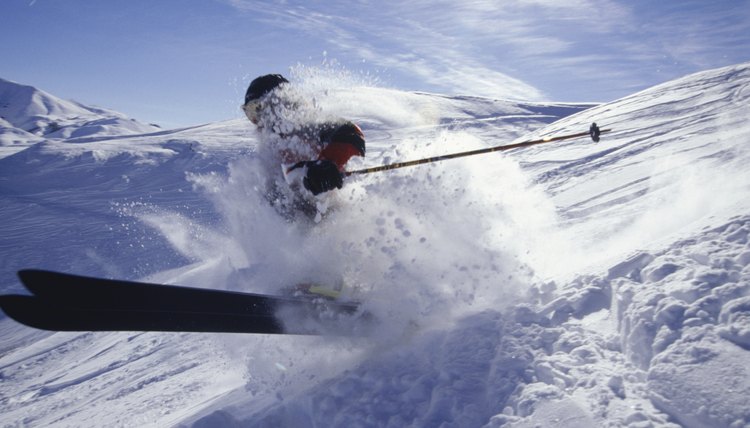What are Good Ski Conditions?

Ski conditions encompass the weather and snow conditions that are available to ski during the winter and spring seasons. While some skiers prefer a certain type of snow pack, general weather and snow patterns allow for fun skiing for beginners and advanced skiers alike. How hard you have to work on the snow will be determined greatly by the ski conditions.
Types of Snow
There are a variety of types of snow depending on where you ski, with different feels and difficulty levels for skiing. The difference between wet snow, granular snow, corn snow and dry snow is based on the snow-to-liquid equivalent. Dry snow will have more air pockets than wet snow, making it lighter with less moisture and more powder. Dry snow is easier to ski for beginners because it involves less carving, but it can slow you down. Wet snow has more moisture, larger snowflakes and goes through a few melt-and-freeze cycles, which produces a crust on the snow. This is OK in the early morning, but the midday sun causes the crust to melt into slush, which can be more challenging for beginner skiers. Wet snow is more prevalent in the Pacific Northwest and Canada. Dry snow can be found in Colorado, Utah and the eastern region of the United States and Canada.
Types of Snow Pack
Everyone loves fresh powder and it is one of the most desirable snow conditions. Powder is soft, fluffy, fresh-fallen snow that makes you feel like you are floating. It also makes a soft landing for crashes. The different types of snow pack include powder, crud, slush, crust and ice. Crud is what develops after more and more people ski over the powder, according to the ABC of Snowboarding. This results in an uneven surface, with lumps of snow mixed with icy spots. Crud is more challenging but is still a good ski condition. Crust is formed when the top layer melts and then freezes over. This is not as easy or as much fun to ski. Slush and ice are not good ski conditions and are extremely challenging for beginning skiers.
Other Factors
Good ski temperature is around 20 to 30 degrees F. This is cold enough that snow will not melt and get slushy, but warm enough that you will not freeze on the lift up the mountain. Another good ski weather condition is light snow, which lays a continual layer of soft powder that keeps you floating downhill.
Spring Skiing
Many people consider spring skiing the most ideal ski condition. The weather is warm but you can still ski on the mountain, and the snow base is still deep from the accumulation of winter storms. Another perk of spring skiing is that most people are finished skiing, so slopes are less crowded, notes Cindy Hirschfeld in "The New York Times.” Some ski resorts also offer reduced-price spring packages.
References
- The New York Times: Stretching Winter, 5 North American Spots for Spring Skiing
- Love To Know: What is Dry Snow
- Genetic and Rare Diseases Information Center. Visual Snow Syndrome. National Center for Advancing Translational Sciences. National Institutes of Health. U.S. Department of Health and Human Services. Updated 2018.
- Schankin CJ, Maniyar FH, Digre KB, Goadsby PJ. 'Visual snow' - a disorder distinct from persistent migraine aura. Brain. 2014;137(Pt 5):1419-28. doi:10.1093/brain/awu050
- Metzler AI, Robertson CE. Visual Snow Syndrome: Proposed Criteria, Clinical Implications, and Pathophysiology. Curr Neurol Neurosci Rep. 2018;18(8):52. doi:10.1007/s11910-018-0854-2
- Van Dongen RM, Waaijer LC, Onderwater GLJ, Ferrari MD, Terwindt GM. Treatment effects and comorbid diseases in 58 patients with visual snow. Neurology. 2019;93(4):e398-e403. doi:10.1212/WNL.0000000000007825
- Schankin CJ, Maniyar FH, Sprenger T, Chou DE, Eller M, Goadsby PJ. The relation between migraine, typical migraine aura and "visual snow". Headache. 2014;54(6):957-66. doi:10.1111/head.12378
- Puledda F, Schankin C, Digre K, Goadsby PJ. Visual snow syndrome: what we know so far. Curr Opin Neurol. 2018;31(1):52-58. doi:10.1097/WCO.0000000000000523
- National Center for Advancing Translational Sciences. Visual snow syndrome. Updated March 6, 2018.
- National Organization for Rare Disorders. Visual Snow Syndrome.
- Unal-Cevik I, Yildiz FG. Visual Snow in Migraine With Aura: Further Characterization by Brain Imaging, Electrophysiology, and Treatment--Case Report. Headache. 2015;55(10):1436-41. doi:10.1111/head.12628
- Wentzell S, Ryan M. Visual Snow Syndrome: A Case Report and New Treatment Option. Clin Med Rev Case Rep. 2018;5:246. doi:10.23937/2378-3656/1410246
- Metzler AI, Robertson CE. Visual Snow Syndrome: Proposed Criteria, Clinical Implications, and Pathophysiology. Current Neurology and Neuroscience Reports. 2018 Jun 22;18(8):52. doi:10.1007/s11910-018-0854-2.
- Puledda F, Schankin C, Digre K, Goadsby PJ. Visual Snow Syndrome: What We Know so Far. Current Opinion in Neurology. 2018 Feb;31(1):52–58. doi:10.1097/WCO.0000000000000523.
- Schankin CJ, Maniyar FH, Sprenger T, Chou DE, Eller M, Goadsby PJ. The Relation Between Migraine, Typical Migraine Aura and “Visual Snow”. Headache. 2014;54:957–966. doi:10.1111/head.12378.
- Unal-Cevik I, Yidiz FG. Visual Snow in Migraine With Aura: Further Characterization by Brain Imaging, Electrophysiology and Treatment—Case Report. Headache. 2015 Nov–Dec;55(10):1436–41. doi:10.1111/head.12628.
- Wentzell S, Ryan M. Visual Snow Syndrome: A Case Report and New Treatment Option. Clinical Medical Reviews and Case Reports. December 31, 2018;5(12):246. doi:10.23937/2378-3656/1410246.
Writer Bio
Caroline Thompson is a professional photojournalist who has been working for print and online publications since 1999. Her work has appeared in the "Sacramento Bee," "People Magazine," "Newsweek" and other publications. She holds a Bachelor of Arts in photojournalism from California State University at Hayward and a personal trainer certification from the university's Health and Fitness Institute.
